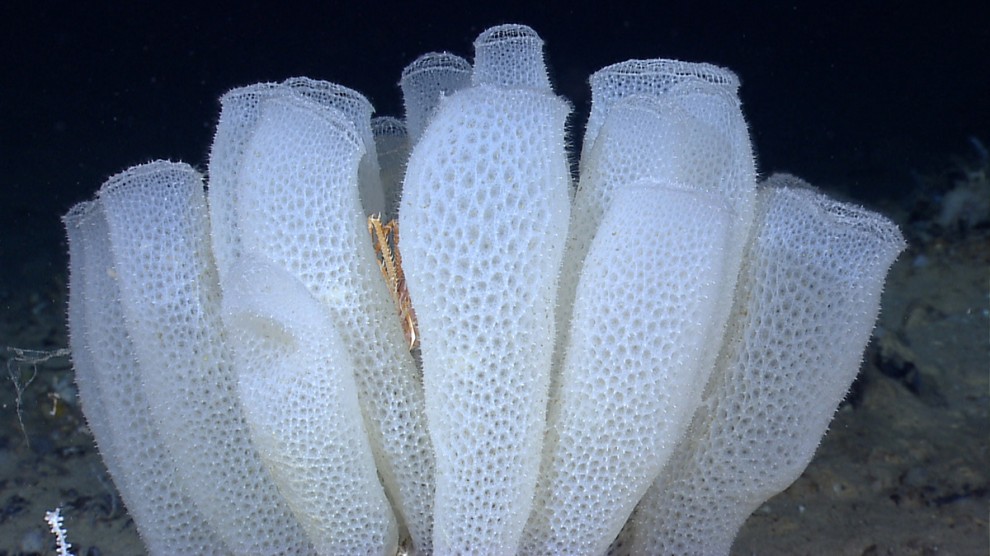Phylum - Porifera (Common Name - Sponge)
Table of Content |
Introduction to Phylum – Porifera

 - Lowest multicellular animals or metazoans without true tissues, i.e., at “Cellular level” of body organization.
- Lowest multicellular animals or metazoans without true tissues, i.e., at “Cellular level” of body organization.
- Familiar as sponges, these animals are well-known for their ability to absorb and withhold fluids.
- The word “Porifera” means pore bearers (Gr., porus = pore; ferre = to bear).
- Their body wall has numerous minute pores, called ostia, through which a continuous current of outside water is drawn into the body.
- About 5,000 species are known.
Brief History
- Robert Grant (1825) finally proved that sponges are animals, and coined the name ‘Porifera’ for these.
- Schulze (1878), Butschli (1884), Sollas (1884) and Delage (1898) separated sponges from other metazoans on basis of embryological studies, and suggested a separate group, “Parazoa” for these.
Body Organisation
(1) Outer Dermal layer or Pinacoderm.
(a) Pinacocytes (Flat cell)
(b) Porocytes (oval)
(2) Inner Choanocytic layer or Choanoderm, Collar cell or Choanocytes (Flagellated)
(a) It is a characteristic of Porifera
(b) Choanocytes discovered by- H.J. Clark
(3) Between these two layers gelatinous material Mesenchyme is there. Consist of Amoebocytes.
(4) Body wall encloses a large cavity, the spongocoel or paragastric cavity with small cavil Choanocytes with flagella is lined in spongocoel and radial canal.
(5) Ceaselless beating of flagellate caused current of water enter through ostia perforating porocytes and various canals and enters in spongocoel and finally leave through large aperture osculum.
Canal System
Canal system of porifera help in nutrition, respiration & excretion, developed due to folding of inner wall there are four types of canal systems:
(1) Asconoid (Simplest canal) e.g. Leucosolenia, Olynthus
(2) Syconoid e.g. Scypha
(3) Leuconoid (Complex and most efficient canal system). e.g. Euspongia & spongilla
(4) Rhagon e.g. Larva of Demospongia
Skeleton
Skeleton is internal; consist of tiny calcarious calcoblast or siliceous spicules silicoblast or fine spongin fibre spongioblast, located in mesenchyme.
There are four types of spicules in sponges
(1) Monoaxon (Usually at osculum)
(2) Triaxon
(3) Tetraaxon
(4) Polyaxon
Characteristics
-
Scleroblast secretes spicules and spongioblast secrets spongin fibre.

-
Digestive cavity and mouth is absent.
-
Nutrition is holozoic.
-
Digestion is intracellular and occurs in food vacuoles of choanocytcs.
-
Food particle strained out by collar cell and pass them to amoebocytes.
-
Food is stored in thesocytes.
-
Distribution of food from ingestive cell to other is brought by the movable amoeboid cell.
-
Respiration and Excretion takes place by diffusion of gases through body surface.
-
Excretory matter is Ammonia.
-
Sponges do not have nervous system.
-
Reproduction takes place by means of
(A) Asexual - By Budding - Special cell mass gemmules containing archaeocytes.Endogenous budding of asexual reproduction in sponge is known as Gemmulation.
(B) Sexual - Sponges are hermaphrodite, fertilization internal and cross fertilization (Protogynous condition).
|
Unique Features
2. Cellular level of body organisation.
3. A canal system of intercommunicating cavities for the passage of a water current.
4. Lack of mouth and digestive cavity.
5. Choanocytes lining the main cavity (spongocoel) or certain canals (radial canals).
6. Presence of spongin fibres.
Salient Features
Phylum porifera has the following salient features:
(1) All the sponges are Aquatic, Sedentary, Asymmetrical or Radially, First multicellular organisms and have cellular grade of organization.
(2) They are diploblastic. Ectoderm is formed by pinacocyte and endoderm is formed by choanocyte. Both layers are called pinacoderm and choandoderm.
(3) The body is perforated by numerous minute pores called ostia.
(4) The ostia open into a large cavity called spongocoel.
(5) The spongocoel opens to the outside by a large opening called osculum.
(6) The sponges possess an endoskeleton in the form of calcareous spicules.
(7) Excretion and respiration occur by diffusion.
(8) They have greater power of regeneration.
(9) Reproduction takes place by asexual or sexual methods.
(10) Development is indirect or direct. The common larval are parenchymula, amphiblastula, etc.
Class 1. Calcarea
(1) Skeleton is formed of Calcareous spicules.
(2) Radially symmetrical.
(3) Choanocyte cells are large and conspicuous
(4) Examples: Clathrina, Leucosolenia, Sycon, etc.
|
|
Class 2. Hexactinellida
(1) Skeleton is formed of six rayed triaxon, silicious spicules
(2) Canal system is branched or unbranched.
(3) Radially symmetrical.
(4) These are also known as glass sponges.
(5) Examples: Pheronema, Hyalonema, etc.
Class 3. Demospongia
(1) Skeleton either absent or present. When present it is either formed of spongin fibres or combination of spongin fibres and silicious spicules.
(2) The silicious spicules when present are never six rayed
(3) The canal system is complicated Rhagon type
(4) These sponges are of great economic importance
(5) Examples: Cliona, Spongilla, Chalina, Euspongia, Hippospongia, Oscarella, etc.


Question 1: A Chamber common to all types of canal system of sponges is called
(a) Paragastric cavity
(b) Radial chamber
(c) Excurrent canal
(d) Incurrent canal
Question 2: A skeleton of calcareous spicules is not found in which of the following groups
(a) Calcarea
(b) Polyplacophora
(c) Echinoidea
(d) Hydrozoa
Question 3: Which one is not typical to all porifers
(a) Perforated body
(b) Choanocytes
(c) System of pores and canal
(d) Presence of spongin fibres
Question 4: Which of the following is a member of phylum porifera?
(a) Sycon
(b) Leucosolenia
(c) Spongilla
(d) All of them
Question 5: Evolution of porifera from protozoans is evidenced by the animals like
(a) Euglena
(b) Chlamydomonas
(c) Volvox


| Q.1 | Q.2 | Q.3 | Q.4 | Q.5 |
| a | d | d | d | c |
Related Resources
-
Click here to refer the Useful Books of Biology for NEET (AIPMT)
-
Click here for study material on Animal Kingdom
To read more, Buy study materials of Animal Kingdom comprising study notes, revision notes, video lectures, previous year solved questions etc. Also browse for more study materials on Biology here.
View courses by askIITians


Design classes One-on-One in your own way with Top IITians/Medical Professionals
Click Here Know More

Complete Self Study Package designed by Industry Leading Experts
Click Here Know More

Live 1-1 coding classes to unleash the Creator in your Child
Click Here Know More

a Complete All-in-One Study package Fully Loaded inside a Tablet!
Click Here Know MoreAsk a Doubt
Get your questions answered by the expert for free





